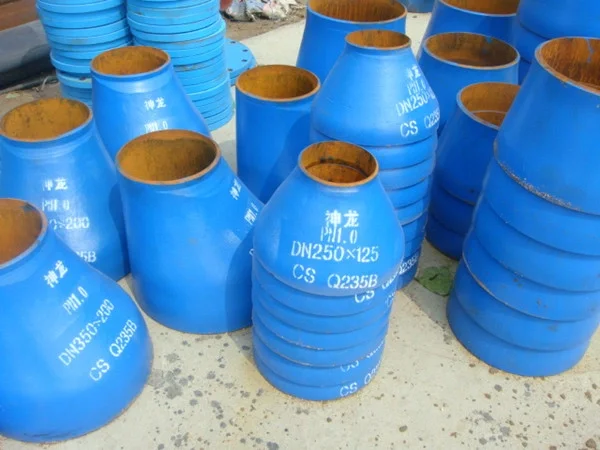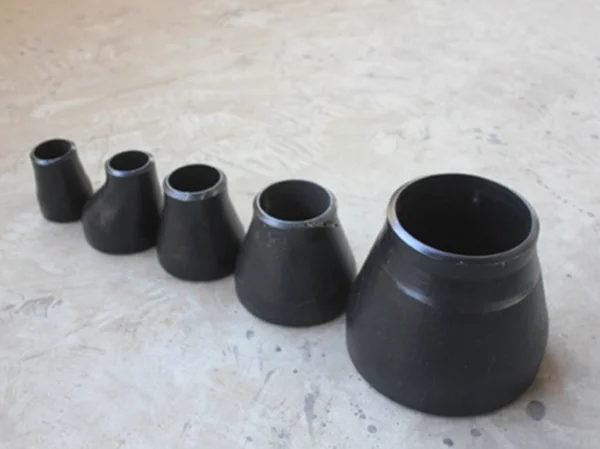Some information about reducers
Introduction and classification of reducers
What is a reducer. Reducer, as the name implies, is used to connect two different diameters or different cross-sections of the interface fittings, therefore, the reducer is also called "small and large head". According to the shape of the pipe, the reducer can be divided into round reducer, rectangular reducer, square reducer and rectangular connection tube with twisting direction; according to the different diameters of the two ends of the pipe, the different pipe diameters are divided into concentric reducer and eccentric reducer. (It is worth noting that round reducers and square reducers are prone to concentric and eccentric diameters, while rectangular reducers produce only single-sided skew and double-sided skew situations.)
Concentric reducer and eccentric reducer two differences pipe fittings end whether in the same axis, the main results are as follows.
1.The midpoint of the orifice at both ends of the reducer is located on the same axis, so when the diameter of the pipe fittings change, the interference with the fluid flow pattern is smaller, which is conducive to fluid flow and suitable for changes in the diameter of gas or vertical liquid pipes.
2.One end of the eccentric reducer is flat, when the diameter changes, the position and direction of the tangent point is different. Accordingly, the installation and function of eccentric reducer pipe are also different. The specific points are: when the orifice tangent point is up, it is called top installation, which is generally used for pump inlet and is conducive to exhaust; when the orifice tangent point becomes bottom installation, it is generally used for regulating valve installation and drainage. In general, the horizontal liquid pipe is generally used as eccentric reducer.

The production method of reducer
The roundness of the reducer should not be greater than 1% of the corresponding end outside diameter, and the allowable deviation is ±3mm. the material of the reducer executes SY/T5037, GB/T9711, GB/T8163, American Standard ASTM A106/A53 GRB, API 5L, APT5CT, ASTM A105, ASTM A234, ASTM A106, DIN German standard and customer requirements standards
Reducer (size) is a kind of pipe fitting used in the reducer of the pipe. Usually the forming process used is shrink pressing, expanding pressing or shrinking and expanding pressing, for some specifications of the reducer can also be used for stamping forming.
1.Reducing / expanding forming
Reducing forming process of reducer is to put the pipe billet with the diameter of the large end of the reducer into the forming die, through the axial direction of pressing along the billet, so that the metal movement along the die cavity and shrinkage forming. According to the size of the reducer reducer, it is divided into one press forming or multiple press forming. The reducer is formed by using a billet smaller than the diameter of the large end of the reducer and using an internal punching die to ream the billet along its inner diameter. The resizing process is mainly to solve the large diameter of the reducer is not easy to shape through the reduction of the situation, sometimes according to the material and product forming needs, the expansion and reduction of the method used in combination. In the reduction or expansion deformation pressing process, according to the different materials and variable diameter, determine the use of cold pressing or hot pressing. Usually, cold pressing is used as much as possible, but hot pressing is appropriate for the case of severe work hardening caused by multiple reducers, the case of thick wall thickness or the material of alloy steel.
2.Stamping and forming
In addition to the use of steel pipe as raw materials for the production of reducers, some specifications of the reducer can also be used to produce steel plate using stamping and forming process. The shape of the punching die used for stretching is designed with reference to the size of the inner surface of the reducer, and the punching die is used to punch and stretch the steel plate after feeding.

Structure and application of reducer
The material of the eccentric reducer is carbon steel, and the method of expression is the diameter of the large head multiplied by the diameter of the small head multiplied by the thickness.
Eccentric reducer standard: national standard American standard British standard and a variety of non-standard high-pressure stamping.
Eccentric reducer pipe shrinkage forming process is equal to the diameter of the large end of the reducer pipe billet into the forming die, through the axial direction of the billet pressing, so that the metal movement along the mold cavity and shrinkage forming. According to the size of the reducer, it is divided into one press forming or multiple press forming.
Eccentric reducers are characterized by significantly higher strength than carbon steel with the same amount of carbon, better toughness and plasticity, as well as good weldability and corrosion resistance.
1.When the flow of fluid in the pipeline has changed, such as increase or decrease, the flow rate requirements do not change, are required to use the reducer.
2.In the pump inlet, in order to prevent cavitation, you need to use a reducer.
3.and instrumentation, such as flowmeter, control valve joints, in order to cooperate with the instrumentation joints, also need to use the reducer.






